Meena Kumari
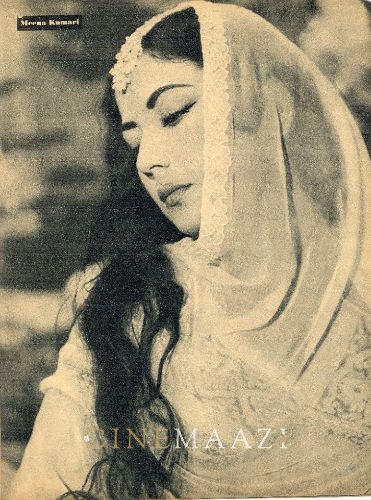
Subscribe to read full article
This section is for paid subscribers only. Our subscription is only $37/- for one full year.
You get unlimited access to all paid section and features on the website with this subscription.
Not ready for a full subscription?
You can access this article for $2 , and have it saved to your account for one year.
- Real Name: Mahjabeen Bano
- Born: 1 August, 1933 (Bombay)
- Died: 31 March, 1972 (Bombay)
- Primary Cinema: Hindi
- Parents: Iqbal Begum, Ali Bux
- Spouse: Kamal Amrohi
Personifying the magic and tragedy of cinema like no one else, Meena Kumari’s exquisite talent shines forth in an array of films such as Baiju Bawra (1952), Foot Path (1953), Parineeta (1953), Dil Apna Aur Preet Parai (1960), Sahib Bibi Aur Ghulam (1962), Aarti (1962), Dil Ek Mandir (1963), Mere Apne (1971), Kaajal (1965), and Pakeezah (1972). Celebrated as cinema’s Tragedy Queen, her professional and personal personas melded in the eyes of the world, and she was essentially seen as an extension of Chhoti bahu, the alcoholic, grief-ridden character she played in the film Sahib Bibi Aur Ghulam. Born Mahjabeen Bano in 1933, she began supporting her poverty-stricken family from a tender age as a child artiste in films. As a lead actress she initially worked mainly in mythologicals or fantasy films, till she appeared in the career-changing Baiju Bawra (1952). There was no looking back for her thereafter. She won four Filmfare Awards in the Best Actress category, and received the inaugural Filmfare Best Actress Award for Baiju Bawra. She had a consecutive win in the second Filmfare Awards (1955) for Parineeta. Further, at the 10th Filmfare Awards (1963), she received all three Best Actress nominations, winning for her performance in Sahib Bibi Aur Ghulam. In 1966 she won her last Filmfare Best Actress award for Kaajal. An Urdu poet, she wrote under the pseudonym Naaz, distancing herself from her public image.
Born on 1 August, 1933 into an impoverished family of stage artistes, her father Master Ali Bux had migrated from Bhera, in current Pakistan, while her mother Iqbal Begum was originally Prabhawati Devi before marriage to Bux. Bux was a Parsi theatre artiste who played the harmonium, taught music, wrote Urdu poetry, and also played minor roles in films like Eid Ka Chand (1932) and also composed music for films such as Shahi Lutera (1965), while Iqbal Begum was a stage actress and dancer who performed under the stage name Kamini, and was also related to the famous Tagore family of Bengal. As a child, Meena Kumari was reportedly even left at an orphanage for a short time before her father changed his mind and brought her back home. Her tryst with cinema started early, when her father managed to snag work opportunities in films for his child. She was cast by Vijay Bhatt in Leatherface (1939), becoming an earning member of the family at just four years of age. Named Baby Meena by Bhatt during the filming of Ek Hi Bhool (1940), she featured in films such as Adhuri Kahani (1939), Pooja (1940), Nai Roshni (1941), Kasauti (1941), Vijay (1942), Garib (1942), Pratiggya (1943) and Lal Haveli (1944).
She was featured as Meena Kumari in Ramnik Production's Bachchon Ka Khel (1946), followed by films such as Duniya Ek Sarai (1946), Piya Ghar Aaja (earlier titled Jalan, 1948) and Bichchade Balam (1948) in which she also sang songs. She went on to act mainly in films from the mythology or fantasy genres such as Veer Ghatotkach (1949), Shri Ganesh Mahima (1950), Laxmi Narayan (1951), Hanuman Patal Vijay (1951) and Aladdin Aur Jadui Chirag (1952). She also featured in nondescript films such as Magroor (1950), Hamara Ghar (1950), Sanam (1951), Madhosh (1951), and Tamasha (1952). Her career received a much-needed boost with Vijay Bhatt's musical, Baiju Bawra (1952). She played the female lead in this romantic drama which turned out to be an overwhelming success at the box office. It was followed by Parineeta directed by Bimal Roy, based on the 1914 Bengali novel by Sharat Chandra Chattopadhyay. Her performance as Lalita won her a Filmfare Best Actress Award. A guest appearance in the multiple award-winning Do Bigha Zamin (1953) directed by Bimal Roy, was followed by the Zia Sarhadi-directed Foot Path; her first film with Dilip Kumar. She starred in Daaera (1953) which written and directed by Kamal Amrohi, as well as Naulakha Haar (1953) and Daana Paani (1953).
The following year she starred in the Muslim social drama Chandni Chowk (1954) directed by B R Chopra, another success at the box office. Films that followed included Baadbaan (1954), Ilzaam (1954), Azaad (1955) which was the second-highest-grossing Hindi film of the year, G P Sippy’s hit Adl-e-Jehangir (1955), Bandish (1955), B R Chopra’s jubilee hit Ek Hi Raasta (1956) which was based on the issue of widow remarriage, the National Award-winning Bandhan (1956), Mem Sahib (1956) which saw her in a modern avatar, the musical hit Naya Andaz (1956), and the hit historical Halaku (1956).
The following year saw her star in the L V Prasad directorial Sharada (1957) winning a Bengal Film Journalists' Association Best Actress Award for her work, the hit comedy Miss Mary (1957), followed by Sahara (1958) which bagged her a Filmfare nomination, Bimal Roy’s hit Yahudi (1958), the above-average Farishta (1958), the hit Chirag Kahan Roshni Kahan (1959), the critically acclaimed Char Dil Char Rahen (1959), romantic drama Shararat (1959), and Chand (1959) which focused on the effects of polygamy before The Hindu Marriage Act of 1955. The following year brought Dil Apna Aur Preet Parai (1960) which won Kumari accolades for her performance. It featured the hit song, the Hawaiian-themed Ajeeb dastan hai yeh. Bhabhi Ki Chudiyan (1961) became one of the highest-grossing Indian films of the year, while critical acclaim poured in for Meena Kumar in Sahib Bibi Aur Ghulam (1962). This brilliant Guru Dutt-directorial won four Filmfare Awards, also bagging Kumari the Best Actress award for her performance as the tragic Chhoti Bahu. She won another Best Actress award from the Bengal Film Journalists' Association for Aarti (1962), followed by a huge hit and another Filmfare Best Actress nomination for Main Chup Rahungi (1962). Dil Ek Mandir (1963) was another box office hit with popular songs, while she starred opposite Guru Dutt in his final film before his demise, the romantic drama Sanjh Aur Savera (1964). It was followed by the Muslim social Benazir (1964), Kidar Sharma’s historical Chitralekha (1964), Gazal (1964) which focused on the right of the young generation to marry according to their the marriage of their choice. Her film Kaajal (1965) went on to be listed among the Top 20 films of 1965, also winning Kumari fourth and last Filmfare award. Phool Aur Patthar (1966) became a thumping golden jubilee hit, while Majhli Didi (1967) was India's entry to the 41st Academy Awards for Best Foreign Language Film, and Baharon Ki Manzil (1968) a suspense thriller, was one of the major hits of the year. The early 70s saw Kumari focus on acting-oriented roles; from amongst films like Jawab (1970), Saat Phere (1970), Gulzar’s Mere Apne (1971), Dushman (1971), Pakeezah (1972) and Gomti Ke Kinare (1972), only Pakeezah starred her in the lead role.
Her swansong Pakeezah (1972), directed by Kamal Amrohi, had first been conceptualised back in the 1950s. The film got stalled several times, due to technical problems and later, due to the couple’s estrangement. Suffering from cirrhosis of the liver, Kumari was aware that her time was limited and tried her best to complete the film, shooting even through her severe illness. Sixteen years in the making, Pakeezah released on 4 February 1972, and Meena Kumari died the following month, on 31 March, at the age of 39. Her demise triggered enormous frenzy, leading to the film becoming a big hit. It enjoyed a successful run of 33 weeks and even celebrated its silver jubilee. Meena Kumari posthumously received her twelfth and last Filmfare nomination for Pakeezah. Telling a story set in Muslim Lucknow at the turn of the 20th century, with its central character Lucknowi nautch-girl Sahbijaan, and her desire to love and be loved, the film is considered a cult classic. With ‘poetry, fantasy and nostalgia rolled into one on an epic scale’, as one critic put it, Pakeezah is indeed to Meena Kumari what the Taj Mahal is to Empress Mumtaz Mahal.
Epitomising the traditional Indian woman, as an actress, Meena Kumari was able to depict the struggle of Indian women of the 50s and 60s. While at the peak of her career, she was the highest-paid actress of her generation. Such was her standing that at one point in time no top hero was willing to work with her, because she essayed powerful roles. Word has it that even the thespian Dilip Kumar found it difficult to keep his calm in front of her, while Raaj Kumar was known to often forget his dialogues while working with Kumari on set. She, in turn, turned mentor to new talents such as Sunil Dutt, Dharmendra, and Rajendra Kumar. Legend has it that she had no use for glycerine—she wept real tears for scenes that required it. She was hailed by Ashok Kumar for her natural talent. Known to be very choosy, once she accepted a role, she put her heart into it and as a consequence is still remembered for her sensitive portrayals. Her dancing drew copious praise from Kathak great, Pandit Lachhu Maharaj who drew attention to the angle of her shoulders when she took a turn while dancing; a grace that cannot be taught. Her voice was a thing of sheer beauty. Having rendered playback as a child artist, as a heroine she sang in films such as Duniya Ek Sarai (1946), Piya Ghar Aaja (1948), Bichchade Balam (1948) and Pinjre Ke Panchhi (1966).
Madhubala, herself a big fan of Meena Kumari’s, was reported to have gushed, "She has the most unique voice. No other heroine has it," while Amitabh Bachchan declared, “No one, not any one, ever spoke dialogues the way Meena Kumari did .. no one .. not anyone to date.. and perhaps never will". Music director Naushad’s assessment—"Hindi film industry may produce great actresses but there would never be another Meena Kumari" will perhaps always ring true.
Writing Urdu poetry under the pseudonym Naaz, her verse was the medium through which she distanced herself from her public image and critiqued the industry. Among her collections are I write, I recite – a vinyl album consisting of her poems was released in 1971, with music by Mohammed Zahur Khayyam. All the nazms in the album were written, recited and sung by Meena Kumari herself. While Tanha Chand (Lonely Moon), a collection of her poems, was compiled by Gulzar and published after her death in 1972, a book about her poems and nazms Meena Kumari, the Poet: A Life Beyond Cinema was published in 2014.
A fashion icon setting trends which were religiously followed, Kumari’s sober and dignified styles from the hair bun to the traditional bindi were adored in the 50s. Her floral or traditional Banarasi silk and Kanjeevaram saris remain a fashion draw, as do her anarkalis, winged eyeliner, and elaborate jewellery.
In the personal space, she secretly married filmmaker Kamal Amrohi in 1952; her family was initially against the union. The marriage was plagued by challenges, and the couple eventually separated but remained married.
Meena Kumari passed away on 31 March, 1972. She was 38 years old. Buried according to husband Amrohi’s wish at Rehmatabad Cemetery, Mazagaon, Bombay, she had earlier requested the following lines as an epitaph: ‘She ended life with a broken fiddle, with a broken song, with a broken heart, but not a single regret’.
-
Filmography (90)
SortRole
-

Sati Anusuyaa 1974
-
Gomti Ke Kinare 1972
-
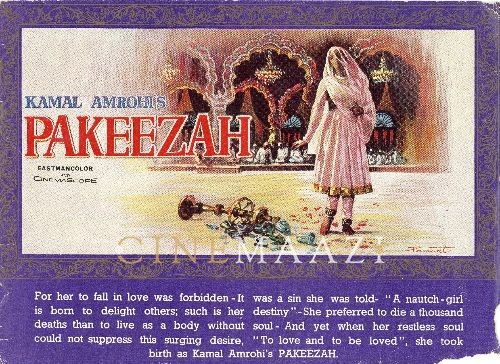
Pakeezah 1972
-
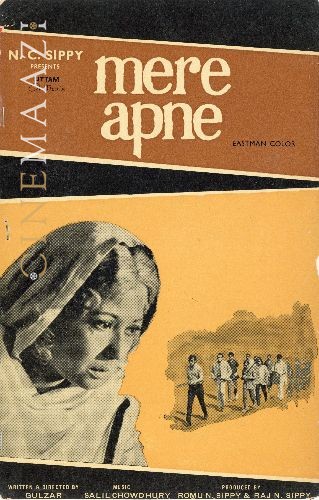
Mere Apne 1971
-
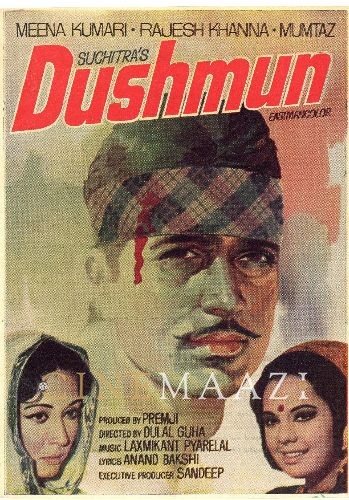
Dushmun 1971
-
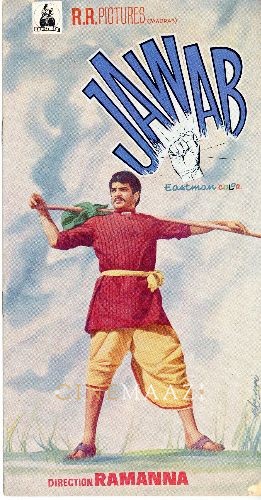
Jawab 1970
-
Saat Phere 1970
-
Raja Simha 1969
-
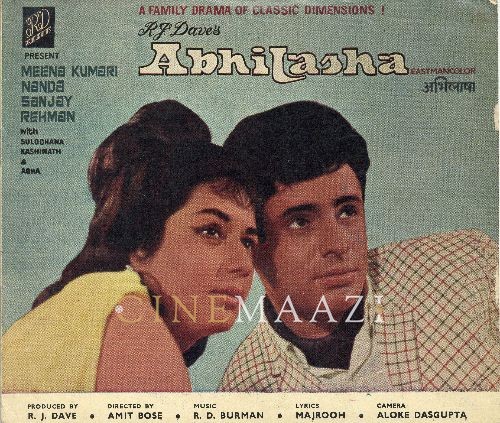
Abhilasha 1968
-
Baharon Ki Manzil 1968
-
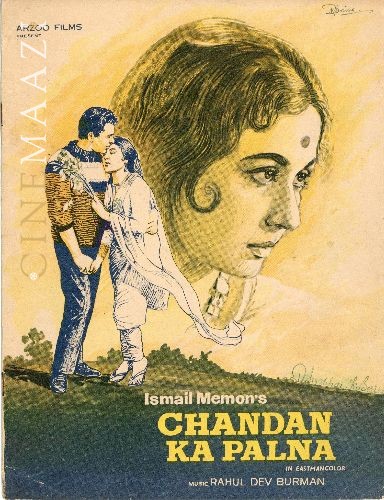
Chandan Ka Palna 1967
-
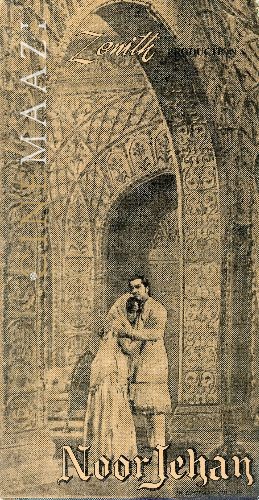
Noor Jehan 1967
-









.jpg)



